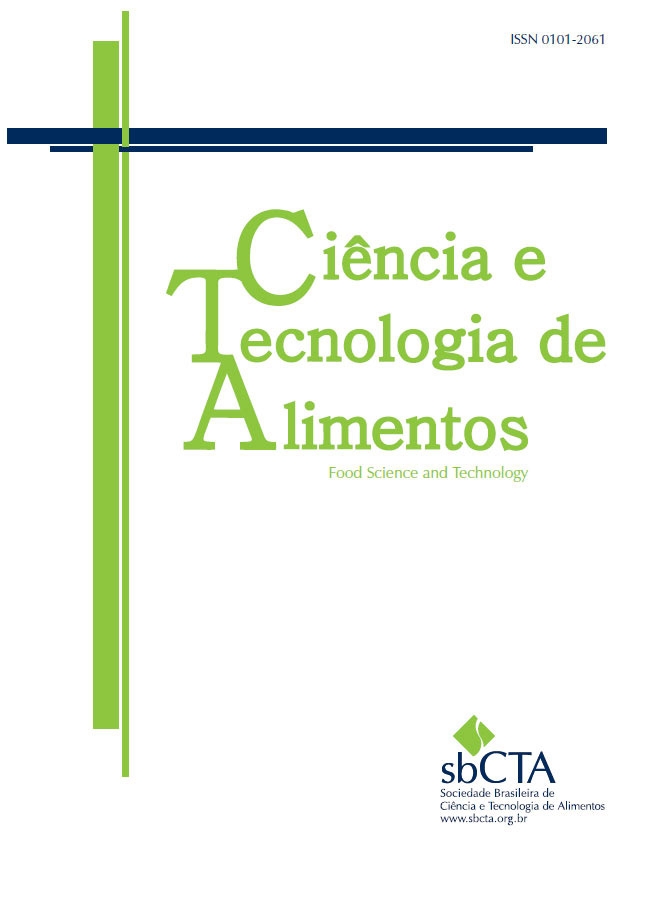Optimization of herbal drink formulation based on aloe vera (Aloe barbadensis Miller) and java spices
DOI:
https://doi.org/10.5327/fst.00369%20Keywords:
Aloe barbadensis Miller, antioxidant capacity, herbal drink, java spicesAbstract
This research aimed to determine the optimum combination of aloe vera and Java spices’ herbal drink formulations. A Design Expert mixture D-optimal was used to analyze the optimal composite formulation. The optimum formula is determined through four stages, namely, the formula planning, formulation, analysis, and optimization stages. The selected formulation was determined based on the response to phenolics, flavonoids, antioxidant capacity tests, and pH. The formulations had pH values ranging from 4.452 to 4.636, the antioxidant capacity values ranged from 2.4796 to 12.5697 mg Ek vit C/100 g, the total phenolic content ranged from 0.0871 to 0.1883 mg GAE/g, and the total flavonoid content ranged from 0.1451 to 0.4210 mg QE/g. The most optimum response is obtained when the desirability value is close to one. The optimum formulation for aloe vera and Java spices herbal drinks consisted of 52.92% aloe vera, 11.58% ginger extract, 1.50% white turmeric extract, and 2.00% galangal extract. The formulation under investigation exhibits a pH of 4.502, an antioxidant capacity of 7.4638 mg ascorbic acid equivalent per 100 g, a total phenolic content of 0.1314 mg GAE/g, and a total flavonoid content of 0.3315 mg QE/g.
Downloads
References
Borhan, F. P., Gani, S. S. A., & Shamsuddin, R. (2014). The use of D-optimal mixture design in optimizing okara soap formulation for stratum corneum application. Science World Journal, 1-8. https://doi.org/10.1155/2014/173979
Chasparinda, M. E., Andriani, M. A. M., & Kawiji. (2014). Effect of the addition of ginger (Zingiber officinale. R) on the physicochemical and organoleptic characteristics of beet juice (Β Vulgaris L.). Jurnal Teknosains Pangan, 3(2).
Christijanti, W., Juniarto, A. Z., & Suromo, L.B. (2019). Hypoglycemic effects of aloe vera peel extract on type 2 diabetic rats. Journal of Physics: Conference Series, 1321(315), 032032. https://doi.org/10.1088/1742-6596/1321/3/032032
Dalanta, F., Kusworo, T. D., Aryanti, N., & Othman, N. H. (2021). Optimization of AC/TiO2/CeO2 composite formulation for petroleum refinery wastewater treatment via a simultaneous adsorption-photocatalytic process using a D-optimal mixture experimental design. Journal of Environment and Chemical Enginering, 9(6), 106517. https://doi.org/10.1016/j.jece.2021.106517
Dhurhania, E., & Novianto, A. (2018). Test the total phenolic content and its effect on the antioxidant activity of various dosage forms of ant nests (Myrmecodia pendens). Jurnal Farmasi dan Ilmu Kefarmasian Indonesia, 5(2), 62-68.
Dwiloka, B., Setiani, B. E., & Purwitasari, L. (2020). The changes in the antioxidant activities, total phenol, curcumin, and hedonic quality of first and second brewing spiced drinks. IOP Conference Series: Earth and Environment Science, 443(125), 012108. https://doi.org/10.1088/1755-1315/443/1/012108
Fardiaz, D. (1997). Functional food and its development through traditional food. Prosiding Seminar Nasional Teknologi Pangan.
Gelgel, K. D., Yusa, N. M., & Permana, D. G. M. (2016). Study of the effect of the type of ginger (Zingiber officinale Rosc.) and the drying time of the leaves on the antioxidant capacity and sensory capacity of wedang uwuh. Jurnal Ilmu Teknologi Pangan, 5(2), 11-19.
Hidayat, I., Zuhrotun, A., & Sopyan, I. (2021). Design-expert software as a tool for optimizing pharmaceutical formulations. Majalah Farmasetika, 6(1), 99-120.
Ismiati, E. (2015). Antioxidant activity of corn silk herbal drink with variations in conditions and boiling time [B.Sc.thesis, Universitas Muhammadiyah Surakarta].
Januari, E. (2017). Optimization of functional drink formulations integrated with moringa leaves, fragrant pandan leaves, and red ginger (Moringa oleifera lamk, Pandanus maryllifolius roxb, and Zingiber officinale rosc) [B.Sc. thesis, Universitas Brawijaya Malang].
Ma’arif, M. S., Machfud, & Sukron, M. (1989). Food process engineering optimization techniques. PAU-Pangan and Gizi.
Maflahah, I. (2010). Analysis of the process of making corn starch (maizena) based on mass balance. Jurnal Embryo, 7(1), 40-45.
Moosavi-Movahedi, A. A., Ghamari, F., Ghaffari, S. M., Salami, M., Farivar, F., Moosavi-Movahedi, F., Johari, A., Aminin., & Agustina, L. N. (2015). Natural peptide anti-glycation effect in the presence of aloe vera phenolic components on human serum albumin. The Royal Society and Chemistry Advances, 5(1), 248-254. https://doi.org/10.1039/C4RA11773E
Nugraha, W. D., Syafrudina., Kusumastuti, V. N., Matin, H. H. A., & Budiyono. (2020). Optimization of biogas production in the Indonesian region by liquid anaerobic digestion (L-AD) method from rice husk using response surface methodology (RSM). IOP Conference Series: Material Science and Engineering, 845(117), 012042. https://doi.org/10.1088/1757-899X/845/1/012042
Nugroho, A. (2012). Utilization of software in research. Universitas Gajah Mada.
Riyanto, & Wariyah, C. (2012). Stability of antioxidative properties of aloe vera (Aloe vera var. chinensis) during the processing of aloe vera drinks. Agritech, 32(1), 73-78.
Siswanto, B., & Ernawati, F. (2013). The role of some micronutrients in the immune system. Gizi Indonesia, 36(1), 57-64.
Sultana, B, & Anwar, F. (2008). Flavonols (kaempferol, quercetin, myricetin) contents of selected fruits, vegetables, and medicinal plants. Food Chemistry, 108(3), 879-884. https://doi.org/10.1016/j.foodchem.2007.11.053
Suryanti, U., Bintoro, V. P., Atmomarsono, U., Pramono, Y. B., & Legowo, A. M. (2014). Antioxidant activity of Indonesian endogenous duck meat marinated in ginger (Zingiber officinale Roscoe) extract. International Journal of Poultry Science, 13(2), 102-107. https://doi.org/10.3923/ijps.2014.102.107
Susilo, E. (2011). Optimization of functional drink formulas based on turmeric (Curcuma domestica Val.), tamarind (Tamarindus indica Linn.), and ginger (Zingiber officinale var. Amarum) using a mix design method (mixture design) [B.Sc. thesis, IPB Bogor].
Wahyudi. (2012). Optimization of the extrusion product formula for macaroni snacks from breadfruit flour (Artocarpus altilis) using a mixed design method (mixture design) [B.Sc, thesis, IPB Bogor].
Werdhasari, A. (2014). The role of antioxidants in health. Jurnal Biotek Medisiana Indonesia, 3(2), 59-68.
Widayat, C. B., Satriadi, H., & Munfarida, S. (2018). Antioxidant activity and total phenolic content in red ginger (Zingiber officinale) based drinks. IOP Conference Series: Earth and Environment Science, 102(131), 012025. https://doi.org/10.1088/1755-1315/102/1/012025
Wiedosari, E. (2007). The role of natural immunomodulators (aloe vera) in cellular and humoral immunity. Artazoa, 17(4), 165-171.
Winarno, F. G. (2008). Food chemistry and nutrition. Gramedia pustaka utama.
Wirakartakusumah, A. (1989). Principles of food engineering. PAU Pangan dan Gizi.
Wulandhari, N. W. T. (2007). Optimization of the formulation of sausages made from surimi catfish (Pangasius pangasius) with the addition of carrageenan (Euchema sp.) and skim milk to improve the quality of sausages [B.Sc, thesis, IPB Bogor].



